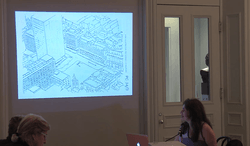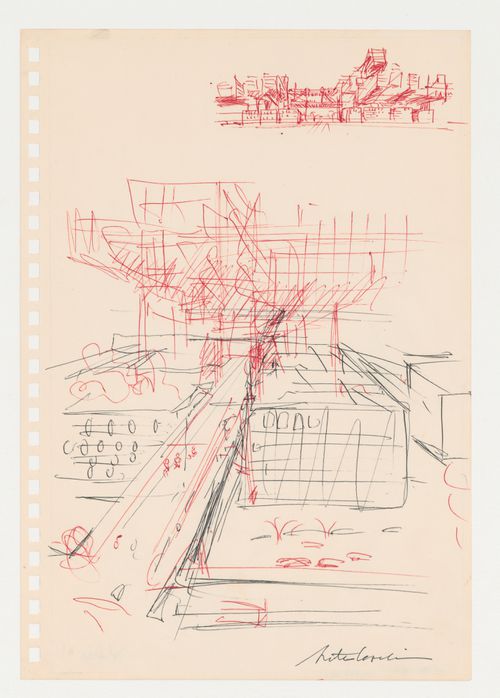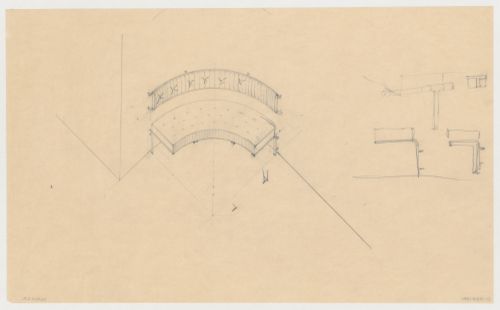Projet
AP018.S1.1958.PR04
Description:
This project series documents the control tower at the Toronto International Airport in Mississauga from 1958-1964. The office identified the project number as 5872. This project consisted of a 100 foot high control tower built onto a single storey building totalling 30,600 square feet in size. The reinforced concrete tower was hexagonal in shape with a steel frame and reinforced concrete slab floor. A transparent skydome forms the ceiling of the central lobby, providing a view of the floor and supporting shafts of the tower. This project won a Silver Massey Medal for Architecture in 1964 and recognition from Canadian Architect magazine and the Beautify Toronto Campaign for its significance. The project is recorded through a presentation board of a photo of the skydome dating from around 1964.
circa 1964
Control Tower, Toronto International Airport, Mississauga, Ontario (1958-1964)
Actions:
AP018.S1.1958.PR04
Description:
This project series documents the control tower at the Toronto International Airport in Mississauga from 1958-1964. The office identified the project number as 5872. This project consisted of a 100 foot high control tower built onto a single storey building totalling 30,600 square feet in size. The reinforced concrete tower was hexagonal in shape with a steel frame and reinforced concrete slab floor. A transparent skydome forms the ceiling of the central lobby, providing a view of the floor and supporting shafts of the tower. This project won a Silver Massey Medal for Architecture in 1964 and recognition from Canadian Architect magazine and the Beautify Toronto Campaign for its significance. The project is recorded through a presentation board of a photo of the skydome dating from around 1964.
Project
circa 1964
Michela Rosso, allocataire d’une bourse d’appui en 2013, présente sa recherche dans les archives de Peter Carter sur le schéma du manoir carré (1962-1985) et montre les différentes facettes de la controverse entourant la tour non construite de Mies van der Rohe, au cœur de Londres. Michela Rosso a obtenu un doctorat de l’École polytechnique de Turin, où elle est depuis(...)
Maison Shaughnessy
30 mai 2013, 18h
« Friends and Enemies of Mies’s Mansion House Square »
Actions:
Description:
Michela Rosso, allocataire d’une bourse d’appui en 2013, présente sa recherche dans les archives de Peter Carter sur le schéma du manoir carré (1962-1985) et montre les différentes facettes de la controverse entourant la tour non construite de Mies van der Rohe, au cœur de Londres. Michela Rosso a obtenu un doctorat de l’École polytechnique de Turin, où elle est depuis(...)
Maison Shaughnessy
dessins
AP046.S1.1983.PR01.297
Description:
This file includes parts list for frames and doors by D'Acier Anjou Inc., joint and louver details by Construction Specialties Limited, and supports by Classic Metal Inc.
1987
Technical drawings, Canadian Centre for Architecture, Montréal, Québec
Actions:
AP046.S1.1983.PR01.297
Description:
This file includes parts list for frames and doors by D'Acier Anjou Inc., joint and louver details by Construction Specialties Limited, and supports by Classic Metal Inc.
dessins
1987
archives
Niveau de description archivistique:
Fonds
AP056
Résumé:
The Kuwabara Payne McKenna Blumberg fonds documents the architectural projects of the firm from 1984-2003. 125 projects are recorded through drawings, photographs, models, textual records, periodicals and paintings. These projects include built work, proposals and competition entries.
1984-2003
Fonds Kuwabara Payne Mckenna Blumberg
Actions:
AP056
Résumé:
The Kuwabara Payne McKenna Blumberg fonds documents the architectural projects of the firm from 1984-2003. 125 projects are recorded through drawings, photographs, models, textual records, periodicals and paintings. These projects include built work, proposals and competition entries.
archives
Niveau de description archivistique:
Fonds
1984-2003
dessins, photographies
ARCH172497
Description:
Photographies du site, d'installations et d'œuvres graphiques de Jacques Rousseau, dessins (plans, rendus) sur divers supports (films, acétates, papier, bristol), catalogue de l'exposition "Architecture du Musée", 1984
Photographies du site, d'installations et d'œuvres graphiques de Jacques Rousseau, dessins
Actions:
ARCH172497
Description:
Photographies du site, d'installations et d'œuvres graphiques de Jacques Rousseau, dessins (plans, rendus) sur divers supports (films, acétates, papier, bristol), catalogue de l'exposition "Architecture du Musée", 1984
dessins, photographies
DR1987:0061
Description:
- This drawing is one of four drawings by Arata Isozaki for the "City in the Air" schemes of 1960-1963. Three of these drawings are studies for the "Clusters in the Air" project of 1960-1962: a sketch showing a general view of the project, DR1987:0117, a more finished version of the same view, DR1987:0062, and a three-stage sketch showing trees becoming a forest, DR1987:0116. The sketch of trees demonstrates the principal idea behind the "Clusters in the Air" project; enormous supports (trunks) support passageways (branches) to which living units (leaves) are gradually added. The trees develope side by side, with branches of different trees joining up, creating a "forest" (Isozaki 1992, 20-23, 29). The subject of this drawing is unclear although it is possibly a conceptual drawing for the Marunouchi Project of 1963, a proposal for a "City in the Air" in the central business district of Tokyo (Isozaki 1992, 27, 29). All four drawings are executed on sheets perforated with square holes for insertion into a spiral notebook.
architecture
ca. 1960-1963
Sketch for an urban structure raised on pylons, possibly for the Marunouchi Project, Tokyo
Actions:
DR1987:0061
Description:
- This drawing is one of four drawings by Arata Isozaki for the "City in the Air" schemes of 1960-1963. Three of these drawings are studies for the "Clusters in the Air" project of 1960-1962: a sketch showing a general view of the project, DR1987:0117, a more finished version of the same view, DR1987:0062, and a three-stage sketch showing trees becoming a forest, DR1987:0116. The sketch of trees demonstrates the principal idea behind the "Clusters in the Air" project; enormous supports (trunks) support passageways (branches) to which living units (leaves) are gradually added. The trees develope side by side, with branches of different trees joining up, creating a "forest" (Isozaki 1992, 20-23, 29). The subject of this drawing is unclear although it is possibly a conceptual drawing for the Marunouchi Project of 1963, a proposal for a "City in the Air" in the central business district of Tokyo (Isozaki 1992, 27, 29). All four drawings are executed on sheets perforated with square holes for insertion into a spiral notebook.
architecture
Série(s)
AP179.S2
Description:
Series 2, Witte Arts Center, Green Bay, Wisconsin, 2000 – 2002, documents the development of a project (unrealized) by Office d’A in response to a real estate brief for a floor of artists’ studios supported by a street level gallery in Green Bay, Wisconsin. The design for the Witte Arts Center addresses functional architectural concerns like light and circulation through elements such as suspended skylights and an open-air staircase. For the staircase in particular, corbelled brick patterning around the interior stairs creates a distortion of the building’s façade nicknamed “the smile.” The series consists of sketches, drawings and reprographic copies from the pre-design to design development phases of the project, a model, and photographic materials. Textual records in the series include correspondence, meeting notes and vendor catalogues. Digital material consists of CAD drawings, 3D models and renderings, images of the model and drawings, correspondence and other documents.
2000 - 2002
Witte Arts Center, Green Bay, Wisconsin (2000 - 2002)
Actions:
AP179.S2
Description:
Series 2, Witte Arts Center, Green Bay, Wisconsin, 2000 – 2002, documents the development of a project (unrealized) by Office d’A in response to a real estate brief for a floor of artists’ studios supported by a street level gallery in Green Bay, Wisconsin. The design for the Witte Arts Center addresses functional architectural concerns like light and circulation through elements such as suspended skylights and an open-air staircase. For the staircase in particular, corbelled brick patterning around the interior stairs creates a distortion of the building’s façade nicknamed “the smile.” The series consists of sketches, drawings and reprographic copies from the pre-design to design development phases of the project, a model, and photographic materials. Textual records in the series include correspondence, meeting notes and vendor catalogues. Digital material consists of CAD drawings, 3D models and renderings, images of the model and drawings, correspondence and other documents.
Series
2000 - 2002
Projet
House, Selsdon
AP144.S2.D42
Description:
File documents an unexecuted project for a detached private residence located at Beech Way in Selsdon, Surrey, (now Croydon, part of Greater London), England, for Jean Newlove (Mrs. Jean McColl). The local planning authority refused the project citing aesthetic considerations. The house was to be constructed as a "series of interleaved reinforced concrete trays" supported by columns ("Cedric Price Supplement No. 2", 'Architectural Design', vol. 41, (January 1971), 36). File contains conceptual and design development sketches that explore exterior elevations, stair and glazing details; axonometric drawings and sections that show relationship between floor levels and functions; and framing plans showing the preliminary structural layout. Material in this file was produced between 1962 and 1964. File contains conceptual drawings, design development drawings, presentation drawings, photographic materials, and textual records.
1962-1964
House, Selsdon
Actions:
AP144.S2.D42
Description:
File documents an unexecuted project for a detached private residence located at Beech Way in Selsdon, Surrey, (now Croydon, part of Greater London), England, for Jean Newlove (Mrs. Jean McColl). The local planning authority refused the project citing aesthetic considerations. The house was to be constructed as a "series of interleaved reinforced concrete trays" supported by columns ("Cedric Price Supplement No. 2", 'Architectural Design', vol. 41, (January 1971), 36). File contains conceptual and design development sketches that explore exterior elevations, stair and glazing details; axonometric drawings and sections that show relationship between floor levels and functions; and framing plans showing the preliminary structural layout. Material in this file was produced between 1962 and 1964. File contains conceptual drawings, design development drawings, presentation drawings, photographic materials, and textual records.
File 42
1962-1964
Projet
CI005.S1.1946.PR1
Description:
In order to better coordinate numerous war memorial committees, the Dutch national government instituted a Central Commission for War and Peace Memorials. The commission initiated a national monument project in 1946 with the direction of J. Henrick Muller, who chose Dam Square, Amsterdam, for its site. The existing plan drew on an existing municipal Amsterdam memorial. Sculptor John Raedecker designed a sculpture group supported by an obelisk and Oud was enlisted by Raedecker to create the memorial's spatial design for the sculptures and urns. Oud chose the memorial site opposite the palace in Dam Square. Despite pressure to change the site position, the committee submitted Oud's design and it was approved in 1950. The sculptures and monument were completed in 1956 with an opening ceremony held in May (Taverne et al. 2001, 457-460). Project series includes partial sections and plans showing sculptures by Raedecker.
1946-1956
National Monument, Dam Square, Amsterdam, Netherlands (1946-1956)
Actions:
CI005.S1.1946.PR1
Description:
In order to better coordinate numerous war memorial committees, the Dutch national government instituted a Central Commission for War and Peace Memorials. The commission initiated a national monument project in 1946 with the direction of J. Henrick Muller, who chose Dam Square, Amsterdam, for its site. The existing plan drew on an existing municipal Amsterdam memorial. Sculptor John Raedecker designed a sculpture group supported by an obelisk and Oud was enlisted by Raedecker to create the memorial's spatial design for the sculptures and urns. Oud chose the memorial site opposite the palace in Dam Square. Despite pressure to change the site position, the committee submitted Oud's design and it was approved in 1950. The sculptures and monument were completed in 1956 with an opening ceremony held in May (Taverne et al. 2001, 457-460). Project series includes partial sections and plans showing sculptures by Raedecker.
project
1946-1956
Axonometric and details for a built-in hall bench for Villa Allegonda, Katwijk aan Zee, Netherlands
DR1984:0148
Description:
- The built-in curved bench and headrest shown in this drawing are for the ground floor hall of Villa Allegonda. Detail drawings for the bench supports appear at upper right and centre right.
design d'intérieur
1931
Axonometric and details for a built-in hall bench for Villa Allegonda, Katwijk aan Zee, Netherlands
Actions:
DR1984:0148
Description:
- The built-in curved bench and headrest shown in this drawing are for the ground floor hall of Villa Allegonda. Detail drawings for the bench supports appear at upper right and centre right.
design d'intérieur


